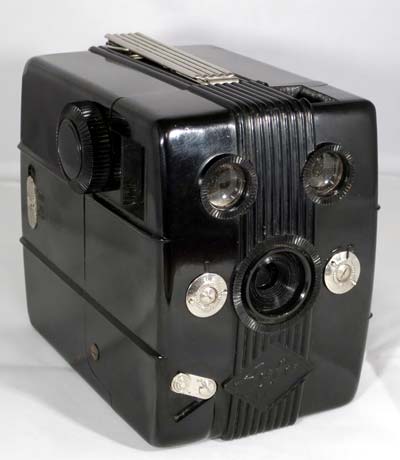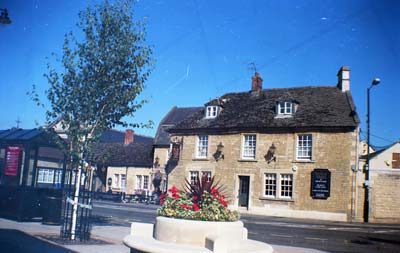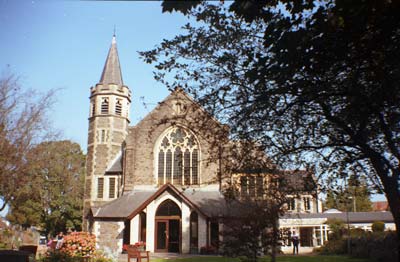Agfa Trolix (Box 14)
Specification

| Manufacturer | : | Agfa |
|---|---|---|
| Produced | : | 1936 - 1940 |
| Classification | : | Medium Format |
| Body Type | : | Box |
| Construction | : | Trolitan |
| Film Type | : | 120 |
| Film width | : | 62mm |
| Image Size | : | 2¼ x 3¼ in |
| No. of Images | : | 8 |
| Lens Type | : | Meniscus |
| Focus Type | : | Fixed |
| Focal Length | : | 95mm |
| Focus Range | : | 6ft to inf. |
| Aperture Type | : | Multihole + yellow filter |
| Aperture | : | f/12, f/22 |
| Shutter Type | : | Rotary |
| Shutter Speeds | : | B,I*(1/50 sec) |
| Size (w x h x d) | : | 88 x 110 x 130 mm |
| Weight | : | 645g |
| * Measured on this camera | ||
Art Deco Credentials
![]()
![]()
![]()
![]()
Significant: Pronounced and self evident
- Produced during the main Art Deco period;
- Made from Trolitan;
- Symmetrical Face;
- Curvilinear design;
- Chrome controls, case locks and handle;
- Ribbing all around moulded into Trolitan;
- Ribbed chrome handle;
- Diamond Agfa logo moulded into front.
Description
The Agfa Trolix, also known as Box 14, is a handsome looking box-type camera from 1936. It is made from Trolitan plastic which is the German equivalent of Bakelite. The use of black and chrome on the front plate gives it an expensive look. It has two reflecting brilliant finders. It has a red window with a swinging cover. The ribbed carry handle is particularly attractive. It has a single tripod socket on the base. The film is loaded by removing the back of the camera. There are two sliding lockes labelled AUF(open) and Zu(close).
The shutter has two modes - timed and instant. The timed shutter is like (B)bulb. The shutter mode is changed by turning a small dial on the front having a Dash for Timed and a Dot for Instant. The instant function is activated when the shutter release is pressed down, and again when the shutter release is moved up. The speed of the shutter on this camera was measured as 1/50 sec.
The aperture is changed by turning another small dial. The dial is marked '1 F 2'. In position '1' the aperture is f/12. In position 'F' the aperture is f/12 with a yellow filter in place. In position '2' the aperture is f/22. The yellow filter works with black & white film to give better contrast, especially between sky and clouds.
How to Use
This camera takes 120 film which is easily available.
As the shutter speed is only 1/50s, it is advisable to use a tripod to get clear shake free images. However, holding it against a wall or other solid object would work as well. For quick snapshots, hold it firmly against your body.
If you don't want to bother with an exposure meter, follow the guide shown. It is based on the 'Sunny 16' rule. Film is so forgiving and will produce acceptable results even when overexposed by 2 or 3 stops or underexposed by 1 stop.
The tables assume that the sun is at least 30 degrees above the horizon - that's 10am - 5pm on a summers day (May - August) in the UK.
Remember that the exposure guide in the manual may not be helpful as it is based on the use of old film with a low ISO value.
Using ISO 100/125 film - shutter speed 1/50s
| Weather Conditions | Shadow Detail | Aperture | Exposure |
|---|---|---|---|
 Sunny SunnySnow/Sand | Dark with sharp edges | f/22 | +1 Stops Overexposed Acceptable |
 Sunny Sunny | Distinct | f/22 | Good |
 Slight Overcast Slight Overcast | Soft around edges | f/12 | +1 Stop Overexposed Acceptable |
 Overcast Overcast | Barely visible | f/12 | Good |
 Heavy Overcast Heavy Overcast | None | f/12 | -1 Stop Underexposed Acceptable |
 Open Shade Open Shade/Sunset | None | f/12 | -2 Stops Underexposed Not Acceptable |
Photographs taken with this camera
Kodak Portra 160 film. All taken at f/12, 1/50s



